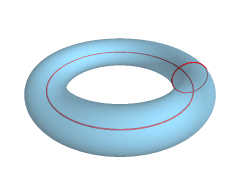|
(2016
midterm assignment) Model Student Midterm answers 2016 #1: Long Essays (Index) |
LITR 4328 |
 |
Eric
Howell
September 26th, 2016
American Romanticism: As Deep and Complex as Love
In
regards to the American Renaissance, some of the most notorious and notable
authors of American literature hail from this particular era. Names such as Poe,
Emerson, Dickenson, and Cooper, and their respective works, are all recognized
within the minds of those whom are, even in the slightest fragment, concerned
with literature. Although these greats resonate with my own perception of
American literature, I am surprised by the actual amount of depth and substance
that lies within the confines, waiting to be discovered and derived, from the
Romantic Period in American literature.
The American Renaissance was birthed following the accomplishments of the
Enlightenment era, a period in American history that was based around scientific
revolution, meritocracy, and a de-emphasis of religious authority. From the
Enlightenment, Americans were given stability through new wealth and a sense of
identity and progress. These advantageous circumstances in American life
provided the framework and opportunity for authors of the new era to expand
their writing styles and formulate what is now known as Romanticism.
Often misconstrued as the characteristics concerning the preoccupation of
love and the expression of affection, Romanticism diverges from the conception
of practical romance in that, although “feelings, emotions, and imagination take
priority over logic and facts” like those sappy individuals thunderstruck with
love, in a literary sense, escapes the here and now, thriving off of nostalgia
and circumventing reality, instead supplanting social norms with vivid,
idealized and abstract settings. The sublimity of nature takes hold in the
writings of Romanticism, propelled by transcendent progression and fueled by
heroic individualism. In addition
to these themes, the gothic style begins to take shape in this literary period,
encapsulating the polarity of the Romantic genre. Opposite of the bright, rich
portrayal of nature and heroism in Romanticism, the gothic capitalizes on tropes
and devices such as the interplay of light and dark, extreme highs and lows, and
the duality of Gothicism and Romance. With so many plush elements and aspects,
one can see why the Romanticism of the American Renaissance is still relevant in
today’s modern times.
One of the most widely recognized and renowned authors of the American
Renaissance, Edgar Allan Poe, exemplifies the nature of gothic writing in
Romanticism like no other. In his short story,
Ligeia, Poe provides readers with a
hefty dose of gothic style and a dash of lighter romanticism.
Writing, “Of
all the women whom I have ever known, she,
the outwardly calm, the ever-placid Ligeia, was the most violently a prey to the
tumultuous vultures of stern passion” (7. 3), Poe mixes elements of both gothic
and romanticism; highlighting the calm, still beauty of Ligeia, placing her
before all women he has ever encountered, Poe immediately shifts the mood,
darkening the ambiance around Ligeia so that the only focus is on the ravenous
attributes of passion and desire. Although I have read several of Poe’s works, I
never identified the duality of his writings. I was under the naive impression
that the majority of his works consistently focused on elements of darkness,
despair, and dire loss. I quickly learned that although themes of shadowy
overcast run unbridled, Poe also plays on the lofty, over-the-top nature of
romanticism in a more affectionate manner. Through close reading of
Ligeia, I was able to better
understand the broad spectrum and range of American Romanticism.
In addition to Poe and his gothic stylizations, another author that helps
wrap my mind around how broad Romanticism can be is Emily Dickenson. Although
Dickenson is not typically categorized as a gothic writer, many of her poems
offer gothic tones and imagery. I am not as familiar with Dickinson as Poe;
however, after reading [I felt a funeral
in my brain], I am motivated to become more interested in Dickinson’s
literary work. Within twenty lines, Dickinson delivers and packs such grim,
almost frantic imagery in a cool-calm demeanor, which seemingly flows with ease.
Dickenson writes “As
all the Heavens were a Bell/ And Being, but an Ear/ And I, and Silence, some
strange Race/ Wrecked, solitary, here —“ (4.1-4.4), allowing the reader to
almost feel the inner battle she as warring.
Her correspondence of the outer and inner world through her unique style
virtually places the reader within her own body, in an eerie, mysterious
fashion.
Another aspect of Romanticism that has been enhanced through course reading
selections is the personification of the divine through the means of nature,
including the correspondence of inner and outer being, as seen within the
writings of Ralph Waldo Emerson and transcendentalism. In Emerson’s
Nature, the divinity of the universe
is expressed through nature, and ultimately through man, as he writes, “Embosomed
for a season in nature, whose floods of
life stream around and through us, and invite us by the powers they
supply, to action proportioned to nature… the universe is composed of Nature
and the Soul” (2.1-5.1). To me, Emerson and his writings embody
Romanticism, and more specifically Transcendentalism. The vivid, picturesque
scene Emerson paints with his words display an abstract, upward, inclusive
spiral, which captures not only man and nature, but more so the divine. By doing
this, Emerson provides readers with an opportunity to perceive the “bigger
picture” and displays the desire to return to “nature.”
James Fenimore Cooper also portrays nature through the eyes of a Romantic era
writer in The Last of the Mohicans,
using exaggerated, sublime descriptions to embellish the role of the divine in
the wilderness. Within the first
chapter, Cooper uses specific language to depict characteristics typically
associated with divinity and applies the dialect to describe nature as
possessing religious connotations. Cooper writes, “The lengthened sheet of the
Champlain stretched from the frontiers [extreme limit of settled land
beyond which lies wilderness]…forming
a natural [existing/caused by
nature/the divine, not mankind]
passage…it received the contributions of another lake, whose waters were so
limpid [free of anything that darkens,
completely clear] as to have been
exclusively selected by the Jesuit
missionaries to perform the typical purification of baptism…The less
zealous English thought they
conferred a sufficient honor on its unsullied [not
spoiled, pure] fountains…”
(Cooper). By depicting nature in this lustrous manner, Cooper creates an
atmosphere of the sublime, a key facet of American Renaissance writing.
The American Renaissance/Romantic period proves to be as deep and complex
as a literal passionate romance. The elements, themes, and ideas concerning
American Romanticism remain rooted in relevancy in American culture to this day,
and as I delve further into the atmosphere of American Renaissance literature, I
am reminded of just how little I know.
 |
 |
 |
